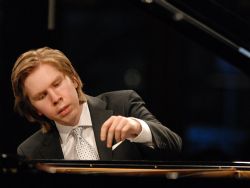|
Recital
ELEGANT VOCAL MASTERY AT ROSES SIGNATURE RECITAL
by Pamela Hicks Gailey
Sunday, February 25, 2024
Recital
DEMANDING SCHUMANN WORK IN MUSIC AT OAKMONT RECITAL
by Terry McNeill
Thursday, November 9, 2023
Recital
RARE RAVEL IN MENDO FESTIVAL'S PRESTON HALL
by Terry McNeill
Thursday, July 20, 2023
Recital
FRENCH FLAVOR IN RARE FOUR-HAND RECITAL
by Judy Walker
Sunday, January 15, 2023
Recital
ASSERTIVE PIANISM IN YAKUSHEV'S OCCIDENTAL RECITAL
by Terry McNeill
Sunday, November 13, 2022
Recital
HEROIC LIM PERFORMANCE AT STEINWAY SOCIETY RECITAL
by Abby Wasserman
Sunday, September 18, 2022
Recital
AGGRESSIVE PIANISM IN MYER'S MENDO FESTIVAL RECITAL
by Terry McNeill
Thursday, July 14, 2022
Recital
UNIQUE ELEGANCE IN GALBRAITH GUITAR RECITAL
by Gary Digman
Friday, April 29, 2022
Recital
ALLURING GLASS WORKS IN WEILL RECITAL
by Terry McNeill
Friday, March 25, 2022
Recital
FORGOTTEN BACH SHINES IN YARDEN'S OAKMONT RECITAL
by Terry McNeill
Thursday, March 10, 2022
|
 |
 Pianist Juho Pohjonen |
THE BALLADE OF JUHO POHJONEN
by Terry McNeill
Sunday, September 14, 2014
Planning a piano program around a single theme or name can be tricky because cutesy connections can easily displace artistic merit. Fortunately, Juho Pohjonen's Sept. 14 recital in the inaugural "Sundays at Schroeder" concert was a textbook example of a successful theme--ballades--supported by wonderful music.
Grieg's seldom-played G Minor ballade had perhaps the most convincing performance of the afternoon. Built on 14 variations on a Norwegian folk song, the work is the composer's best extended-form piano piece. Mr. Pohjonen played it in a unhurried way with careful control of dynamics and just a hint of sadness. Pedaling was precise, and even the three most extroverted variations were clearly phrased and articulated.
Brahms' four early Op. 10 ballades completed the first half. Here again the Finnish pianist played with stable chordal weighting and fastidious thematic voicing. The gentle D Major Andante featured good staccato playing in the middle section. The Intermezzo moved from darkness to a cantabile of radiant light in the concluding Romanza. The slow playing had sentiment without a hint of sentimentality. Everything in the four components of the ballade's ersatz sonata structure was always in place.
In contrast to the efforts of Brahms and Grieg, each of the four Chopin ballades tells a story. Here Mr. Pohjonen stumbled. He is an exemplar of his musical generation in that rubatos are tight, inner voices are absent, repeats are played the same way each time, and the vocal nature of Chopin's exquisite melodies is slighted. The pianist's technique, however, is well suited to the unfolding agitation of the ballades. The F Major and the A-Flat Major received the most convincing playing benefiting from small pedal effects, fast right-hand scales and engaging rhythms.
Less compelling were the bookend ballades, arguably among the pinnacles of Chopin's genius. In both the G Minor and F Minor, pianistic frenzy often displaced thematic ardor and grandeur. The intricate and tumultuous coda of the F Minor became jumbled in the artist's rush to secure a potent finish.
Responding to a standing ovation from the audience of 160, Mr. Pohjonen played a limpid Grieg lyric piece, Op. 43, No. 6, "To the Spring." His captivating performance ended with two beguiling arpeggiated chords and a crossover left-hand pianissimo F.
|
